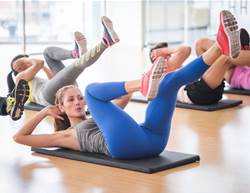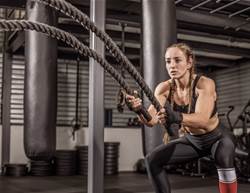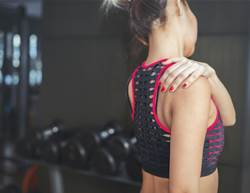Just because your chronological age increases every year doesn’t mean your physical fitness and strength has to decline at the same time. In fact, new research suggests that many of the problems we associate with getting older have less to do with ageing and much more to do with being sedentary.
Starting from whatever age you may be, you can make small changes that will help you stay fit and flexible through the decades. Take the time to assess your routine holistically, from a social and physical perspective, and you will notice the difference as you age. One simple change that will stand you in good stead throughout this process is finding the people in your life who will support you in your goals, and maybe even come along for the ride. In one study, physical activity plus companionship – in this case, a Wii bowling game played with a research assistant – was more effective for reducing loneliness and boosting mood than watching TV with someone. Anything that gets you moving with other people will work.
Although each decade of your life comes with specific challenges that conspire to make you less active, you can overcome them with the right alterations to your routine.
Find your decade below, follow our advice, and keep moving.
40's
The busy decade
CHALLENGE: Finding time to exercise
This may be your busiest decade – and, as a result, you might put other important parts of your life ahead of physical activity. But without regular exercise, strength and cardiovascular fitness can begin to decline rapidly in your 40s.
SOLUTION
Do more in less time
Researchers have found that brief but physically challenging exercise sessions can improve your health just as well as longer sessions.
In a three-month Canadian study, one group of participants rode a stationary bicycle at a steady, moderate pace for 45 minutes three times a week. Another group cycled for seven minutes three days a week, alternating pedalling as fast as possible for 20 seconds with slowing down to an easy, relaxed pace for two minutes.
At the end of the experiment, the people in the short workout group improved their markers of cardio fitness and insulin sensitivity just as much as the people who cycled for 45 minutes. You can mimic the brief-but-intense style, called high-intensity interval training (or HIIT), with almost any type of cardio exercise.
Sneak movement in all day
“Find ways to get movement done while you’re also getting life done,” says personal trainer Breena Maggio. “If you can fit in a five-minute activity break every half hour, that’s 80 minutes of moving every day.” Getting up for a glass of water counts. So does standing up and doing shoulder rolls, taking the stairs instead of the elevator, and using a basket rather than a trolley at the supermarket.
Increase strength
Resistance training is essential now (and in every decade to come) because you slowly lose muscle mass as you age if you don’t stress your muscles regularly. And less muscle means a slower metabolism, greater weight gain, and less strength to do the things you enjoy. It can become a vicious cycle but you can head that off by doing the two body-weight exercises at right. The squat and the push-up both work the major muscle groups. The variations of these moves shown here are appropriate for your 40s. With each subsequent decade, we describe slightly easier versions of these strength exercises.
Key moves

Hands-overhead squat
Hold a rolled-up bath towel between hands overhead. Stand with feet a bit more than hip-width apart, toes pointing slightly out to sides, knees lined up with toes. Sit back with hips and bend knees as if sitting in a chair. Keep knees pointing forward and chest lifted while lowering hips. Don’t let knees travel forward past toes. Descend until thighs are parallel to floor or you feel your lower back flatten. Press through heels to return to standing. Do 10 reps.

Low hands-elevated push-up
Place hands on bench or arm of sofa with arms straight and hands directly below shoulders. Walk feet back to push-up position, forming straight line from head to heels. Bracing core muscles, lower body until chest nearly touches bench or sofa arm. Don’t let hips sag at any point. Pause and push back to starting position as quickly as possible. That’s 1 rep. Do 10 to 15.
50's
The decade of change
CHALLENGE: Waning oestrogen
When this hormone declines during perimenopause and menopause, your muscles start to lose their size and power. As oestrogen ebbs, your body’s ability to metabolise blood sugar decreases, and fat accumulates more easily around your middle. This visceral fat takes up residence near your organs, increasing your risk of heart disease and diabetes. Low oestrogen is also associated with fatigue and moodiness.
SOLUTION
Find an activity you love and make it routine
Can a regular fitness program eliminate the negative effects of declining oestrogen? “Studies suggest you can come close,” says kinesiologist Peter Tiidus. Your 50s are the ideal time to create an exercise schedule you can stick with. The trick is finding an activity that’s so much fun you’d hate to miss it.
Push yourself harder
Research shows that bouts of vigorous exercise deliver the greatest benefits and can be particularly helpful with the problems that hit many women in their 50s. In a study in the Journal of Physiology, women going through menopause who performed moderately intense workouts kept their hot flushes to a minimum. In other studies, high-intensity cardio routines helped overweight women reduce fat around their middles better than slow and steady workouts did. “That doesn’t mean everyone needs to go to a gym and start doing hard interval training,” says sports medicine expert Matthew Robinson. “It could be as simple as choosing a walking route that has a few more hills on it.”
Maintain bone density
Oestrogen loss also weakens bones. But you can fight back by doing bone-strengthening exercises that work against gravity. Walking, hiking, running, dancing, skiing, playing tennis, and doing other activities that stress your limbs cause your body to lay down new bone tissue, making bones denser and stronger. The resistance exercises shown here, coupled with foot-pounding cardio exercise, will help keep your bones strong.
Key moves

Supported Squat
Stand facing the vertical edge of an interior door and grasp the handle on each side with your hands. Alternatively, grasp edge of a kitchen sink with both hands. Holding doorknobs or sink securely, lean back with arms straight and slowly bend knees and sit hips back as if sitting in a chair. Descend until thighs are parallel to floor or you feel your lower back flatten. Press through heels forcefully to stand up. Do 10 reps. (If you can’t go down far enough to feel quads and glutes working, place a rolled-up towel under your heels to elevate them slightly.)

On-Knees Push-Up
Get on the floor on all fours with arms straight and hands directly under shoulders, knees directly under hips. Lift feet off floor. Engage core, forming straight line from head to knees. This is starting position. Keeping elbows near sides, slowly bend arms to lower chest to floor, then straighten arms to press back to starting position. Do 10 reps.
60's
The stay strong decade
CHALLENGE: Combating Muscle Loss
Starting in your 30s, you can lose as much as 3 to 5 per cent of your muscle mass each decade if you’re not regularly active. Fat then infiltrates your muscles. You may not notice significant weight gain, but that steady muscle drain will start catching up with you, making it harder to get up from sitting on the floor or lift a heavy bag of groceries. As you enter your 70s, your balance can become an issue, making falls more likely.
SOLUTION
Get stronger
“You don’t need your muscles to be bigger; you need them to be stronger,” says Isabelle Dionne, a researcher specialising in ageing. And you can acquire strength at any age in a relatively short time. In fact, it took only 10 weeks for a group of people in their 60s to increase their leg strength by 42 per cent, according to a 2016 study in the Journal of Strength and Conditioning Research.
Do ‘functional exercises’
These are moves that mimic the way you use your body in daily life, such as squatting, bending down, lifting and reaching. Stronger hips and glutes allow you to walk longer, climb stairs better, and reduce chances of falling, says. “Stronger butt muscles can also mean a healthier pelvic floor, helpful for women who experience incontinence,” Maggio says.
Many people also lose strength and flexibility (called range of motion) in their shoulders without knowing it until they unsuccessfully try to grab a rarely used item off a high shelf. To keep your shoulders in shape, reach your arms toward the ceiling one at a time. Work your way to being able to clasp your hands in front of you and lift them toward the ceiling. Do 5 to 10 reps 3 times a day.
Keep up with your walking – or dancing sessions
You still need cardiovascular exercise that elevates your heart rate and puts a smile on your face, so continue that fun activity you started in your 50s. Try to schedule these sessions for days when you aren’t doing the two body-weight exercises at right.
Add balance training
“You want to have the ability to walk down the street and turn your head to look at something without it affecting your balance,” says Maggio. Even simple exercises a few times a day will help. For example, stand next to a wall or chair back for balance, then standing on your right leg, bend the left knee to lift left foot behind you. Try to balance for one minute. Then balance on the opposite leg.
Key moves

High elevated-hands push-up
Stand behind sturdy chair or, ideally, sofa. (Avoid using a lightweight chair that can slide under pressure.) Place hands shoulder-width apart on chair back with straight arms. Walk feet back until body forms straight line from head to heels. This is starting position. Brace core and slowly bend arms to lower chest toward chair. Don’t allow elbows to spread outward; keep them tucked against sides. Pause at lowest point, then press into chair to straighten arms. Do 10 reps.

Chair squat
Stand in front of a chair (once again a sturdy one that won’t slip) with feet hip-width apart. Extend arms forward, parallel to floor. This will help you balance. Slowly bend knees and sit hips back, lowering glutes toward chair. If this is difficult, stack pillows on seat to height you need in order to control descent. Sit for a moment before rising. Try to get up without using hands on armrests or bottom of chair. Press into heels to stand. Do up to 10 reps.










